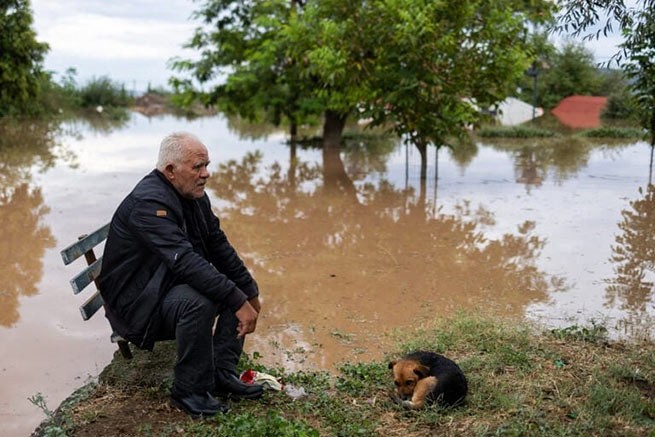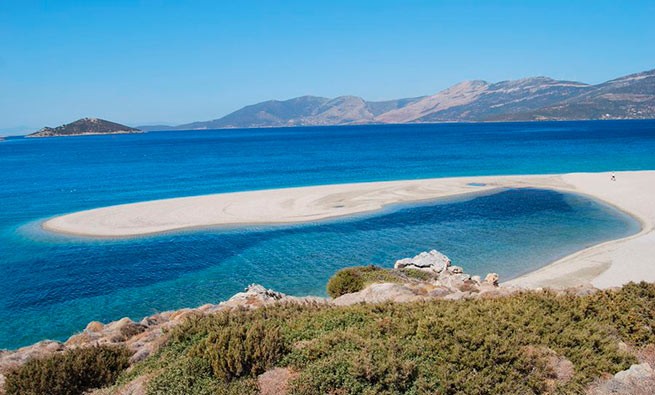Purple jellyfish spread throughout the Greek seas. And some areas of the country have faced a problem due to their appearance.
Experts warn that her bite is not treated with ammonia, but requires a different approach.
Purple jellyfish originally originated in the Ionian Sea but have now been found on the beaches of the Aegean Sea and many beaches in Attica. And this, given the summer, is of great concern. The sting of this species of jellyfish is especially painful due to the neurotoxin, so it is very important to know how to react to this and what to do first.
As Athenian News wrote earlier, the purple jellyfish has already been found in the Ionian Sea, Halkidiki, Rhodes, in the northeast of the Aegean Sea, on the beaches of Attica and the south of the Peloponnese.
According to Epameinondas Christou, the scientific director of the Greek Center and oceanographer Epameinondas Christou, on the air of the SKAI TV channel, the purple jellyfish is born in the open sea, at a depth, but with windy sea currents it is transferred to the beaches.
“A population of purple jellyfish Pelagia noctiluca has been discovered in the Aegean since last year. This means that all beaches that communicate with the Aegean have a chance to show at least one hit. “Usually they do not move in flocks, but in 1-2 individuals,” he notes.
Medusa Pelagia
Pelagia (Pelagia noctiluca), related to disk jellyfish, exists only in the medusa stage. The edge of her umbrella is divided into eight petals, where the sense organs are located – vision, a rudimentary sense of smell, as well as organs of balance. This is a medium-sized jellyfish, rarely exceeding 12 cm in diameter of an umbrella.
The “cap” is bell-shaped, its color can vary from purple to brownish red. The frilled edge of the bell is equipped with eight thin, armed stinging cells, tentacles, and four oral lobes extending from the mouth opening.
The name of this jellyfish is translated from German as “evening light” – because of the colorful color of the dome and the ability to emit light when touching any objects under water.
What to do if you are attacked by a jellyfish?
Mr. Hintiroglu advises bathers that if there are too many jellyfish, avoid immersion in the water, as there is a high chance that you will be stung. If, nevertheless, a jellyfish has scolded you, you can use ammonia (wipe the place) and a little anesthetic gel (τζελ ανακούφισης) to relieve redness at the site of the “bite”.
Additionally, you can do the following:
- Carefully remove possibly stuck parts of the jellyfish from the skin. But not with bare hands! Because the poison can be transferred to them and cause irritation. Use plastic, such as a credit card.
- Rinse the bite with sea water. Never use fresh water, vinegar, ammonia, as this will worsen the situation.
- jellyfish venom inactivated by a slightly alkaline solution (baking soda dissolved in an appropriate amount of sea water), and not by acidic solutions.
- Apply a cold compress to relieve irritation
- Apply cortisone ointment to the bite site.
- Monitor the heart rate and breathing of the victims – some patients may experience allergic reactions and pain shock.
If symptoms are severe and persist, contact your nearest pharmacy as you may need a cortisone injection.
Distribution in Attica
Most purple jellyfish have been recorded in the Saronic Gulf. According to the iNaturalist map, here are some of the popular beaches in Attica where dangerous marine life was spotted in 2022:
- Kavouri beach
- Vouliagmeni coast
- Glystra beach (Lagonisi)
- Nisaki beach (Lavrio)
- Koroni Beach (Porto Rafti)
- Avlaki Beach (Porto Rafti)
- Vravrona beach
- Argira Akti (Nea Makri).
On the inaturalist.org there is a map showing which areas have the highest concentrations of jellyfish, making it possible to know where we can swim carefree and where we can’t.







More Stories
Residents of 5 regions of Greece received "a storm warning"
Dolphins appeared in Thermaikos this morning
Most polluted countries in 2023: Greek regions with worst air quality